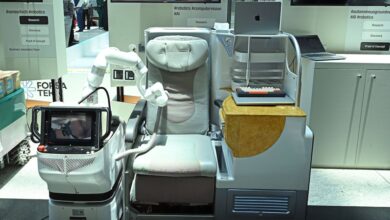Indian AI and Robotics Startup Swaayatt Robots Secures $4 Mn to Advance Level 5 Autonomy

Bhopal-based Indian AI and Robotics startup Swaayatt Robots recently raised $4 million at a valuation of $151 million from US investors. The company will further raise $7 million at a valuation of $175 million.
“In 2021, we raised $3 million, of which we have utilised only $650,000. So in total, we now have $6.3 million to carry our research forward. We are already operating in cities, highways, and off-road locations,” said Sanjeev Sharma, chief of Swaayatt Robots, in an exclusive interview with AIM.
“By the end of this year, we’ll be creating a blueprint that could solve Level Four Autonomy globally. To scale that model, we may raise around $1.5 billion,” said Sharma.
In 2021, investors worldover poured a record $9.7 billion into autonomous vehicle development. However, last year that amount dropped by nearly 60% to just $4.1 billion. According to a McKinsey report, autonomous driving is the future, with self-driving vehicles projected to become a $300 billion to $400 billion revenue opportunity by 2035.
Sharma added that the company is planning a major demo in August. “If the August demo doesn’t excite Sam Altman and Elon Musk, along with the world, I don’t know what will,” he said. Earlier this year, the company executed a demo where it claimed to have achieved Level 5 Autonomy.
The autonomous driving scene in India is still in its nascent stages, but several startups like Minus Zero, Flowdrive, Flux Auto, and Netradyne are actively working to develop self-driving technologies designed for the country’s chaotic road conditions.
Recently, Swaayatt Robots conducted a demo where their autonomous vehicle avoided piles of soil and rocks dumped on the road for construction purposes.
Negotiating a construction site with well-structured traffic cones is typically considered a challenge by the autonomous driving industry in the West. “You will notice our vehicle made a 90-degree turn at an unmanaged intersection,” said Sharma, adding that it is a huge problem even for companies like Tesla and Waymo.
Last year in October, the company enabled autonomous vehicles to negotiate bidirectional traffic on single-lane roads. The demo was conducted at a relative speed of 44 kilometers per hour. “Now, that R&D is going to be scaled up to an extent where the relative velocity at the point of crossing can be maintained at 60 kilometers per hour,” said Sharma.
Focus on Autonomous Driving R&D
As of now, Swaayatt Robots hasn’t really sold their technology to anyone and has been conducting demos with Mahindra Bolero. However, in the near future, the company will focus on OEM integration in existing vehicles, specifically targeting the military and autonomous trucking market.
“For autonomous driving markets in the military domain, we cannot expect new vehicles to be operated in service, you would want to develop a system that can be retrofitted into these aftermarket vehicles,” said Sharma.
He added that aftermarket segments in autonomous trucking in North America are humongous. “If you look at the US trucking market, I mean, it’s an $800 billion addressable market,” said Sharma. He further said that Swaayatt Robots has been in talks with some of the fleet owners in the US.
Regarding India he said, “We have understood the requirements of almost every single OEM in the country. We are in touch with most of the OEMs in India, except for Mahindra. It’s ironic because Anand Mahindra recently praised us.”
Even though we are not in touch with Mahindra directly, he explained that Mahindra’s vehicles are robust and the easiest to modify. “Mahindra has this Mobileye system, which is incorporated into the XUV700.”
Better Than Tesla?
Sharma likes to position Swaayatt as an R&D company, and unlike Tesla at this stage, it is not planning to sell cars anytime soon. “What we are doing is very sophisticated R&D in the general autonomous navigation domain to make autonomous driving happen,” he said.
“There is no agency on the planet, be it Musk’s Tesla or Altman’s OpenAI, that is working on bi-directional traffic,” he said, adding that in the October 2023 demo, their vehicle successfully negotiated bi-directional traffic on a single lane.
He added that by 2030, only four to five autonomous driving companies will survive, highlighting the immense R&D challenges involved. He emphasised that safety is a crucial area to address. Referring to GM’s Cruise accident, he pointed out that it resulted in a total halt of operations and several investigations.
Taking a dig at Comma.ai, he said, “If it were possible to download these packages from the internet and solve the problem of autonomous driving, companies like Tesla and Waymo wouldn’t survive.”
Talking about another Indian startup, RoshAI, he said the company isn’t doing anything new that Cruise, Waymo, and Zoox haven’t already done. “We are not getting funding in India because the country doesn’t invest in R&D,” he said.
Sharma is a huge admirer of Wavye AI. “Since 2019, with the advent of Wavye AI, people have been discussing autonomy without relying on maps. We were the first technology to enable vehicles without the reliance on high-definition maps. In 2017, we implemented multi-RL agents without requiring any maps,” he said.
“Our R&D is focusing on unsupervised learning, where we don’t record labeled data. We have reduced our R&D to the extent that there are only five algorithms now that require labeled data,” he added.
Until now, the company has been conducting demos exclusively with Mahindra Bolero. In the near future, the company plans to demonstrate with multiple vehicles, including Thar and Fortuner. “One demo we will be doing will have Thar and Bolero crossing each other in an autonomous fashion,” concluded Sharma.



